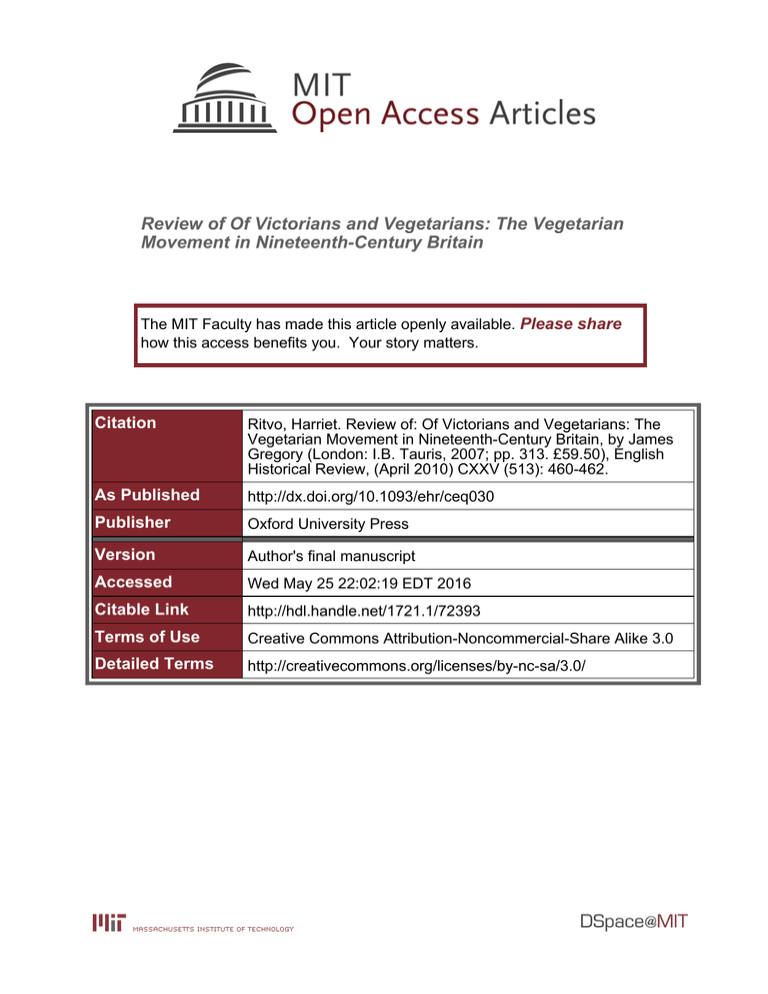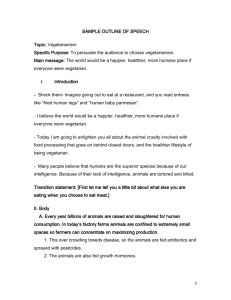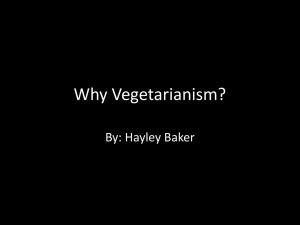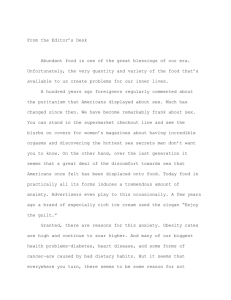Review of Of Victorians and Vegetarians: The Vegetarian Please share
advertisement

Review of Of Victorians and Vegetarians: The Vegetarian Movement in Nineteenth-Century Britain The MIT Faculty has made this article openly available. Please share how this access benefits you. Your story matters. Citation Ritvo, Harriet. Review of: Of Victorians and Vegetarians: The Vegetarian Movement in Nineteenth-Century Britain, by James Gregory (London: I.B. Tauris, 2007; pp. 313. £59.50), English Historical Review, (April 2010) CXXV (513): 460-462. As Published http://dx.doi.org/10.1093/ehr/ceq030 Publisher Oxford University Press Version Author's final manuscript Accessed Wed May 25 22:02:19 EDT 2016 Citable Link http://hdl.handle.net/1721.1/72393 Terms of Use Creative Commons Attribution-Noncommercial-Share Alike 3.0 Detailed Terms http://creativecommons.org/licenses/by-nc-sa/3.0/ Of Victorians and Vegetarians: The Vegetarian Movement in Nineteenth-century Britain, by James Gregory (London: Tauris Academic Studies, 2007; pp. xii + 313. £57.50). Historians are every bit as likely as the next person to see the past as the reflection of the present. Thus the labor movement, the civil rights movement, and the women’s movement have all inspired historical subdisciplines. More recently, animal advocacy has had a similar impact. In his exhaustively researched survey, James Gregory explores the antecedents of the gustatory arm of the modern humane movement. He sees these antecedents as distinctively Victorian. That is, he does not explore the entire history of vegetarianism, which stretches back at least to ancient Greece, nor does he spend much time on Romantic individualists like Shelley. Instead, he is concerned with organized, institutional vegetarianism, which began, in his view, around 1838. As he persuasively demonstrates the extent to which Victorian vegetarianism reflected its social and cultural contexts, he raises several other questions to which the answers are more elusive. How important was vegetarianism in nineteenth-century Britain? And how closely did Victorian vegetarianism resemble its contemporary avatar? The structure of the book reinforces Gregory’s emphasis on institutionalization. Of Victorians and Vegetarians begins with a long chapter—by far the longest—that chronicles the development of the organized movement into the early twentieth century. Vegetarianism figured in the commitments of various radical groups in the 1820s and 1830s, whether their major focus was religious, philosophical or political; the Vegetarian Society was founded in 1847. The movement experienced internal strains of various sorts—not only disagreements about appropriate practices and tactics, but also regional tensions between the north, where the movement had first coalesced, and London, which came to play an increasingly important role. After an early period of growth, the movement seemed to stagnate after midcentury, then experienced new vigor in the late Victorian period, when a number of local societies were established in the provinces. The subsequent chapters are thematic, teasing out threads woven into the initial overview. Gregory demonstrates the importance of notions of purity (and of avoidance of the contamination associated with meat-eating) to many nineteenth- century vegetarians. This set of attitudes allied vegetarianism with the temperance movement and other forms of virtuous abstinence. Related was the conviction that vegetarianism could cure or prevent various physical afflictions, including tuberculosis, which allied vegetarians with the adherents of alternative healing and against orthodox medical practice. Many vegetarians were motivated by concern for animals, but overall humanitarianism was a less significant component of the nineteenth-century movement than was hygiene. Vegetarians did not inevitably share the beliefs of political radicals, but they often did. Gregory shows how the perceived eccentricity of vegetarianism was both a public relations problem for the movement, and an inducement for some individuals to join. On a more practical level, Gregory describes the way vegetarians actually ate as well as the way they portrayed their diet to the skeptical public. Most were particularly concerned to counter the notion that vegetarian food was unappealing, although a few extreme advocates of purity hoped to reduce food to pure nutrition, devoid even of flavor. The public was invited to enjoy elaborate vegetarian banquets, while vegetarian cookbooks and restaurants proliferated in the course of the nineteenth century, the latter patronized by prosperous ladies and gentlemen, as well as by underpaid clerks in search of cheap sustenance. Largely absent from the restaurants and deaf to the many appeals directed at them were the poorer members of Victorian society. They were naturally suspicious of middle-class suggestions that they adopt a diet that was odd as well as inexpensive, detecting a covert excuse for lowering their wages. If laborers were scarce in the vegetarian movement, women were more numerous, although, as was usual at the time, their proportions in the rank and file were not reflected in the leadership. Gregory’s final chapter deals with the representation of vegetarianism. He notes that, despite a few distinguished literary adherents, vegetarianism did not leave much of a trace in Victorian prose and poetry, except in utopian fiction such as Samuel Butler’s Erewhon. It was occasionally the focus of debate in scientific or political contexts. But on the whole vegetarians were rare in print because they were rare in the flesh. Thus, although it was the intermittent object of (mostly critical) attention from the cultural mainstream, the vegetarian movement of the nineteenth-century remained on the fringes. It was consistently recognized as novel, yet Gregory argues that its relationship to modernity was complex—it arose in such quintessentially modern locations as Manchester, but in some of its manifestations it could seem nostalgic or reactionary. Whether or not the current popularity of vegetarianism can be traced back to the century before last, Gregory demonstrates that the Victorian movement is well worth understanding on its own terms. Harriet Ritvo Massachusetts Institute of Technology





